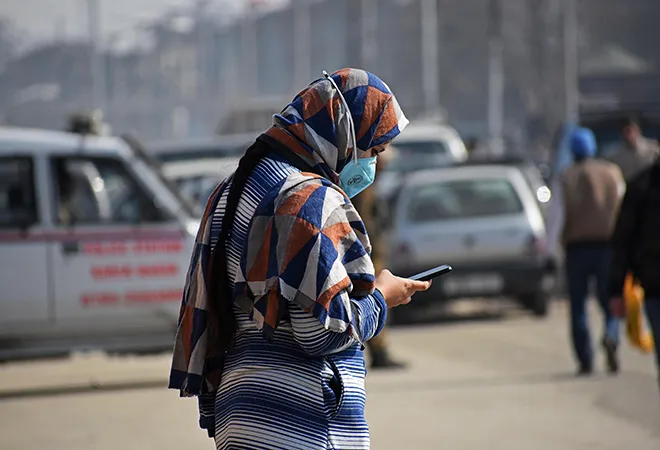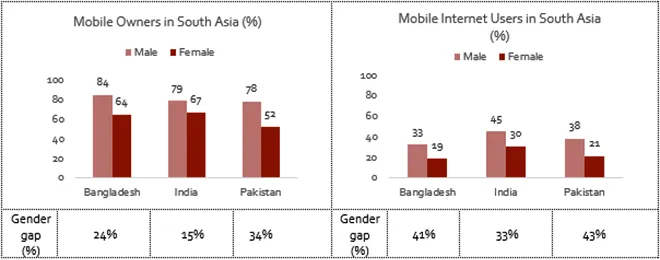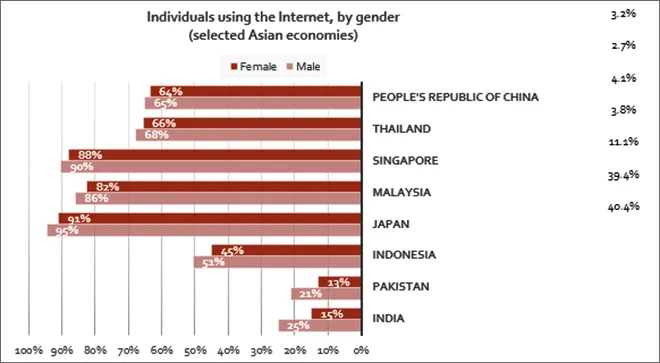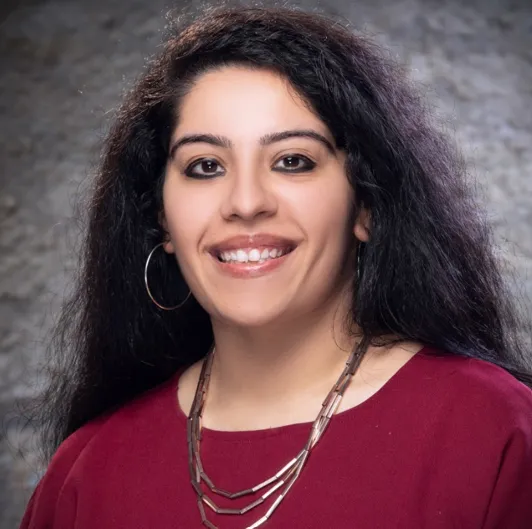
As COVID-19 coursed through countries, governments responded with lockdowns that drove people towards digital marketplaces. Globally, digital adoption escalated by five years in merely two months in 2020. India has set a target of reaching a US $1 trillion digital economy by 2025, a five fold growth from the US $200 million in 2017–18.
Yet, while COVID-19 propelled a 500 percent increase in tele-health consultations, a structural shift towards online shopping with e-retail reaching 95 percent of Indian districts, and digital payments touching the 100 million transactions per day mark, it amplified another trend: The gendered digital divide.
Bangladesh’s gender gap in mobile ownership stood at 24 percent and 41 percent in mobile usage. Pakistan’s gender gaps were even higher at 34 percent for mobile ownership and 43 percent for mobile usage.
Indian women are 15 percent less likely to own a mobile phone, and 33 percent less likely to use mobile internet services than men. In 2020, 25 percent of the total adult female population owned a smartphone versus 41 percent of adult men. In comparison, Bangladesh’s gender gap in mobile ownership stood at 24 percent and 41 percent in mobile usage. Pakistan’s gender gaps were even higher at 34 percent for mobile ownership and 43 percent for mobile usage. Despite the mobile ownership gap reducing from 26 percent to 19 percent, and mobile internet use gap from 67 percent to 36 percent, between 2017 to 2020, South Asia continues to have the widest mobile gender gaps globally.
 Source: GSMA. 2021. Mobile Gender Gap Report 2021.
Source: GSMA. 2021. Mobile Gender Gap Report 2021.
Within Asia-pacific, India had the widest gender gap in internet usage in recent years, a gender gap of 40.4 percent with only 15 percent of women accessing the internet versus 25 percent of men. In comparison, in other Asian countries, the gender gap stood at 39.4 percent in Pakistan, in 11.1 percent in Indonesia, and 2.3 percent in People’s Republic of China.
 Source: International Telecommunication Union, 2021
Source: International Telecommunication Union, 2021
This gendered digital divide is often born out of a triple disadvantage for women in India. First, there is a rural-urban digital divide, such that rural broadband penetration is only 29 percent against a national average of 51 percent. Across states, women in rural areas are less likely to own mobile phones, with this rural-urban divide being the narrowest in Goa, Kerala, and Northeastern states, and the widest in West Bengal, Gujarat, Maharashtra, Andhra Pradesh, and Telangana. Second, there is an income-based digital divide between households. Given the average price for data is US $0.68/GB in India, our estimates show that each GB of data costs low-income households (earning less than US$2/day) 3 percent of their monthly income versus 0.2 percent for middle-income households (earning US $10–$20 per day). Finally, intra-household discrimination prevents women from equitably accessing digital devices within the domestic sphere, which in turn widens the gender-based digital divide.
There is a rural-urban digital divide, such that rural broadband penetration is only 29 percent against a national average of 51 percent.
Even when they are permitted to own or use household-level mobile devices, women’s online activity is often governed by male relatives. While mobile phones are viewed as a risk to women’s reputation pre-marriage; post-marriage, phone-use is viewed as an interruption to caregiving responsibilities. Women generally refrain from speaking on their phones in public places, preferring to conduct their conversation within the home, owing to prevailing social norms and fear of judgement. In this social structure, women have found themselves excluded from the growing digital economy post COVID-19, especially when aspiring for online schooling, skill training, entrepreneurship, and work opportunities.
Between March 2020 to February 2021, Indian schools were fully closed for 62 percent of instruction days, and partially for 38 percent. These school closures placed 320 million students including 158 million girls at risk of dropping out and reaching large learning gaps. During this period, nearly three-quarter of rural students, across government/private schools, received teaching material over WhatsApp, and nearly 1 in 10 parents purchased a smartphone for online learning. However, during consultations with our team at Nikore Associates, several stakeholders noted that families exhibited a preference for male family members during the COVID-19 period. They ensured their sons had the privilege of digital devices and data packs access even when facing income constraints, but did not extend the same treatment to their daughters.
Digital illiteracy and unfamiliarity with digital platforms deterred women entrepreneurs from moving to online marketplaces post COVID-19. Stakeholder consultations by Nikore Associates found that despite their incomes being nearly wiped out due to cancellation of physical fairs and exhibitions during COVID-19, Jhuri-makers (bamboo artisans) in West Bengal were reluctant to move to online platforms due to limited knowledge of social media and digital marketing channels, combined with high data costs. Women Self-Help Group (SHG) members across states like Maharashtra, Telangana, Andhra Pradesh, and Gujarat shared that even though women in their community were using phones for personal use, they were unable to make financial transactions online, and did not use phones for their businesses.
Digital illiteracy and unfamiliarity with digital platforms deterred women entrepreneurs from moving to online marketplaces post COVID-19.
The gendered digital divide is also preventing women and girls from accessing government social security benefits and even booking COVID-19 vaccination slots. Community-based organisations (CBOs) in Maharashtra shared that despite the State government announcing cash support for domestic workers in April 2021 to combat the economic impact of the second wave, many women were unable to access this relief, as they were not registered on government portals and were unaware of the online registration process. Further, the gender gap increased as vaccinations opened to wider population groups, with the female to male vaccination ratio worsening from 0.96 at end-March 2021 to 0.9 at end-June 2021. Online registration being mandatory to avail the COVID-19 till June 2021 has been a key reason for this gap.
On a more encouraging note, there are several examples to show that concerted efforts for enhancing digital literacy and financial support for accessing devices at the community level can improve women’s livelihoods. Mann Deshi Foundation, a community-based financial services enterprise in Maharashtra, introduced a low-cost EMI programme that allows women to purchase smartphones. Approximately 80 percent of the women in their community purchased smartphones by availing this scheme. Several “Digital Didis” were trained and engaged to help women navigate online platforms and digital marketplaces. Thanks to these hybrid training programmes and focused support, women entrepreneurs joined WhatsApp-based and online marketplaces to sell masks, processed foods, textiles, and other products during COVID-19. The Human Development and Research Centre in Gujarat started a “mobile library” for young women from low-income households to borrow phones to attend online skill training sessions. The Maharashtra State Rural Livelihood Mission organised online skill training for women SHGs on mask production and trading on digital marketing websites, and facilitated a partnership with Amazon to help women entrepreneurs survive the pandemic.
Stakeholder consultations with CBOs also illustrated that the benefits of enhanced access to phones went beyond livelihood support, especially in rural areas. Owning a mobile phone allowed rural women to contact CBOs for counselling and medical resources during the pandemic. Rural women with smartphones were more likely to search the internet to get additional information regarding COVID-19 symptoms and treatment and rely on multiple data sources.
Providing equitable access to smartphones and the internet will equip women with the knowledge and resources they need to effectively participate in the national economy.
Moving forward, governments and private sector organisations should support CBOs to upscale community-led digital literacy and digital financial inclusion programmes to address the gendered digital divide. Programmes and initiatives across three action pillars should be prioritised:
- Easing access to mobile devices, e.g.m by providing free mobiles/tablets to school-going girls, female health workers (including Accredited Social Health Activists, Anganwadi Workers, and Auxiliary Nurse Midwives), female teachers and female community leaders and the rural/urban poor; or offering affordable smartphone loans for women through corporate social responsibility and government schemes.
- Digital literacy programmes for women and girls, including increasing public investment in the PM Gramin Digital Saksharta Abhiyan scheme from its current allocation of INR 300 crores in FY2022, of which 40 percent is for women and girls; launching tailored digital training courses for women entrepreneurs on digital marketing and digital payments; and integrating digital literacy in school curricula.
- Investment in rural digital connectivity through the rapid implementation of the BharatNet programme to provide rural broadband connectivity and establishing village level high speed internet connectivity hubs.
While there is no doubt that India is digitising rapidly, the country’s women must not be left out of the virtual conversation. Providing equitable access to smartphones and the internet will equip women with the knowledge and resources they need to effectively participate in the national economy. It is. therefore, imperative to not only increase women’s smartphone ownership as it assists in internet adoption, but also to accelerate digital literacy programmes and work towards ending digital discrimination based on gender norms.
Research assistance: Shruti Jha, Unmuktman Singh, Ishita Mahajan
Note: The authors are part of Nikore Associates, a youth-led economics research and policy think tank. Several findings in this article draw on consultations with over 60 stakeholders belonging to CBOs, academic institutions, government agencies, women-led SHGs, and corporate sector organisations conducted by Nikore Associates between September 2020 to May 2021 to understand the impact of COVID-19 on women’s lives and livelihoods.
The views expressed above belong to the author(s). ORF research and analyses now available on Telegram! Click here to access our curated content — blogs, longforms and interviews.






 PREV
PREV


